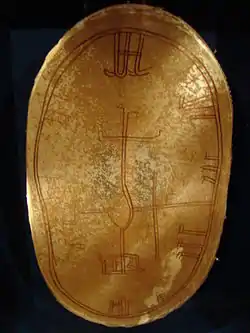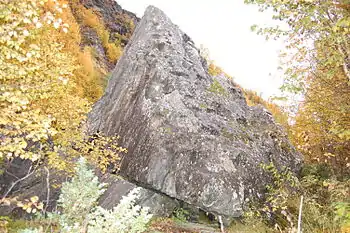Sámi shamanism
Traditional Sámi spiritual practices and beliefs are based on a type of animism, polytheism, and what anthropologists may consider shamanism. The religious traditions can vary considerably from region to region within Sápmi.

Traditional Sámi religion is generally considered to be Animism. The Sámi belief that all significant natural objects (such as animals, plants, rocks, etc.) possess a soul, and from a polytheistic perspective, traditional Sámi beliefs include a multitude of spirits.[1] Sámi traditional beliefs and practices commonly emphasizes veneration of the dead and of animal spirits. The relationship with the local animals that sustain the people, such as the reindeer, are very important to the kin-group.[1]
Deities and animal spirits
Aside from the bear worship, there are other animal spirits such as the Haldi, who watch over nature. Some Sámi people have a thunder god called Horagalles. Rana Niejta is "the daughter of the green, fertile earth".[2] The symbol of the world tree or pillar, similar to that found in Finnish mythology, which reaches up to the North star may also be present.[3]
The forest spirit of some of the Sámi people, Laib Olmai, is traditionally associated with forest animals, which are regarded as his herds, along with granting either good or bad luck in hunting. His favour was so important that, according to one author, they made prayers and offerings to him every morning and evening.[4]
Sieidis

In the landscape throughout Northern Scandinavia, one can find sieidis, places that have unusual land forms different from the surrounding countryside, and that can be considered to have spiritual significance. Each family or clan has its local spirits, to whom they make offerings for protection and good fortune. The Storjunkare are described sometimes as stones, having some likeness to a man or an animal, that were set up on a mountain top, or in a cave, or near rivers and lakes. Honor was done to them by spreading fresh twigs under them in winter, and in summer leaves or grass. The Storjunkare had power over all animals, fish, and birds, and gave luck to those that hunted or fished for them. Reindeer were offered up to them, and every clan and family had its own hill of sacrifice.[5]
Noaide
A noaidi was a male mediator between the human world and saivo, the underworld, on the behalf of the community, usually using a Sámi drum and a domestic flute called a fadno in ceremonies.
Ancestors
One of the most irreconcilable elements of the Sámi's worldview from the missionaries’ perspective was the notion "that the living and the departed were regarded as two halves of the same family." The Sámi regarded the concept as fundamental, while the Christians absolutely discounted any possibility of the dead having anything to do with the living.[6] Since this belief was not just a religion, but a living dialogue with their ancestors, their society was concomitantly impoverished.[7]
List of deities
The Sami religion differed somewhat between regions and tribes. Although the deities were similar, the spelling of their names could vary between regions. The deities could also overlap: in one region, one deity could appear as several separate deities, and in another region, several deities could be united in to just a few. Because of these variations, they have therefore been somewhat confused with each other. They main deities of the Sami were as follows:[8][9][10][11]
- Akka - a collective group of fertility goddesses, including Maderakka, Juksakka and Uksakka.
- Beaivi - goddess of the sun, mother of humankind.
- Bieggagallis - husband of the sun goddess, father of humankind.
- Bieggolmai 'Man of the Winds' - god of the winds.
- Biejjenniejte - goddess of healing and medicine, daughter of the Sun, Beaivi.
- Horagalles - god of thunder. His name means 'Thor-man', also called "Grandfather", Bajanolmmai, Dierpmis, and Tordöm.
- Jahbme akka - the goddess of the dead and mistress of the underworld and the realm of the dead.
- Ipmil 'God' - adopted as a native name for the Christian God (see the related Finnish word Jumala), also used for Radien-attje.
- Lieaibolmmai - god of the hunt, and of adult men.
- Madder-Attje - husband of Maderakka and father of the tribe. While his wife give the newborns their bodies, he gives them their soul.
- Mano, Manna, or Aske - god of the moon.
- Mubpienålmaj - the god of evil, influenced by the Christian Satan.
- Radien-attje - Creator and high god, the creator of the world and the head divinity. In Sámi religion, he is passive or sleeping and is not often included in religious practice. Created the soul of human kind with his spouse. He was also called Waralden Olmai.
- Raedieahkka - wife of the high god Radien-attje. Created the soul of mankind with her spouse.
- Rana Niejta - spring goddess, the daughter of Radien-attje and Raedieahkka.[2] Rana, meaning 'green' or by extension 'fertile earth', was a popular name for Sámi girls.
- Radien-pardne - the son of Radien-attje and Raedieahkka. He acts as the active proxy of his passive father, performing his tasks and will.
- Ruohtta - god of sickness and a death god. He was depicted riding a horse.
- Stallo - feared cannibal giants of the wilderness.
- Tjaetsieålmaj - "the man of water", god of water, lakes and fishing.
See also
References
- Holloway, Alan "Ivvár". "The Decline of the Sámi People's Indigenous Religion". University of Texas.
- Donner, Otto (1876). "Lieder der Lappen - Lappalaisia lauluja". Suomi-sarjan Toinen Jakso, 2 Oso: 13. Cite journal requires
|journal=(help) - Leeming, pp. 135
- Pre- and Proto-historic Finns by Abercromby, pp. 161
- Pre- and Proto-historic Finns by Abercromby, pp. 163-164
- Rydving, Håkan (1993). The End of Drum-Time: Religious Change among the Lule Saami, 1670s-1740s. Uppsala: Almqvist & Wiksell International.
- Holloway, Alan “Ivvár”. "The Decline of the Sámi People's Indigenous Religion". TexasU.
- Hofberg, Herman, Lapparnes hednatro, 1879 ('Sami Paganism')
- Holmberg-Harva, Uno, Lapparnas religion: (Lappalaisten uskonto, 1915), Centre for Multiethnic Research [Centrum för multietnisk forskning], Uppsala, 1987 ('The faith of the Sami')
- Karsten, Rafael, Samefolkets religion: de nordiska lapparnas hedniska tro och kult i religionshistorisk belysning, Stockholm, 1952 ('The Sami religion')
- Reuterskiöld, Edgar, De nordiska lapparnas religion, Norstedt, Stockholm, 1912 (The religion of the Northern Sami)
Bibliography
- Abercromby, John (1898). Pre- and Proto-historic Finns. D. Nutt.
- Bäckman, Louise; Hultkrantz, Åke, eds. (1985). Saami Pre-Christian Religion: Studies on the Oldest Traces of Religion Among the Saamis. Stockholm: Almqvist & Wiksell.
- Leeming, David Adams (2003). European Mythology. Oxford University Press. pp. 133–141 Finnic and Other Non-Indo-European Mythologies. ISBN 9780195143614.
External links
- Folklore, Boundaries and Audience in The Pathfinder (a film review by Thomas A. DuBois in SamiCulture) University of Texas
- The Sámi people Nordic FAQ
- Folktales of Meandash, the mythic Sámi reindeer (Part 1) Folklore.ee
- Folktales of Meandash, the mythic Sámi reindeer (Part 2) Folklore.ee
- "Sieidi" Encyclopaedia of Saami Culture University of Helsinki
- "The Sacred" Encyclopaedia of Saami Culture University of Helsinki